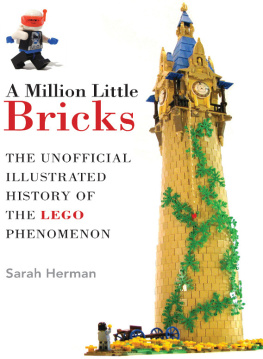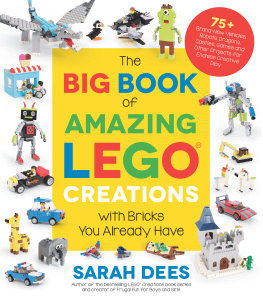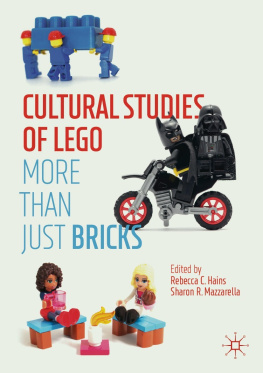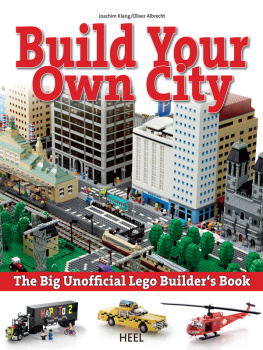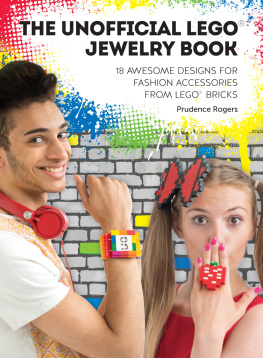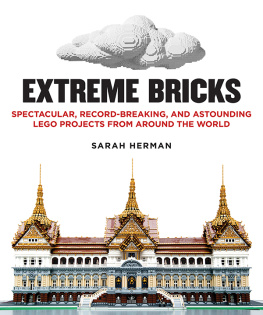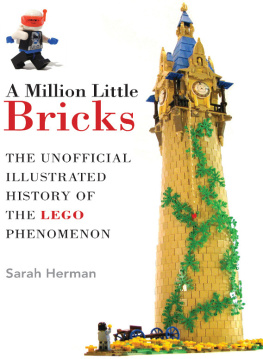A Million Little
Bricks
A Million Little
Bricks
THE UNOFFICIAL
ILLUSTRATED
HISTORY OF
THE LEGO
PHENOMENON
Sarah Herman

Copyright 2012 by Sarah Herman
First published under the title Building a History in Great Britain in 2012 by Remember When, an imprint of Pen & Sword Books Ltd
All Rights Reserved. No part of this book may be reproduced in any manner without the express written consent of the publisher, except in the case of brief excerpts in critical reviews or articles. All inquiries should be addressed to Skyhorse Publishing, 307 West 36th Street, 11th Floor, New York, NY 10018.
Skyhorse Publishing books may be purchased in bulk at special discounts for sales promotion, corporate gifts, fund-raising, or educational purposes. Special editions can also be created to specifications. For details, contact the Special Sales Department, Skyhorse Publishing, 307 West 36th Street, 11th Floor, New York, NY 10018 or info@skyhorsepublishing.com.
Skyhorse and Skyhorse Publishing are registered trademarks of Skyhorse Publishing, Inc., a Delaware corporation.
Visit our website at www.skyhorsepublishing.com.
10 9 8 7 6 5 4 3 2 1
Library of Congress Cataloging-in-Publication Data is available on file.
ISBN: 978-1-62087-054-9
Printed in China
LEGO, the LEGO logo, the Brick and Knob configurations and the Minigure are registered trademarks of the LEGO Group which does not sponsor, authorize, or endorse this book.
For Ianbecause you love me enough to let me
build your Unitron Monorail (set 6991).
Contents
Acknowledgments
W hile writing a book often feels like a solo voyage, there are many people who have helped me along on my LEGO adventure. Thank you to Jens Nygaard Knudsen, Nathan Sawaya, Kenneth Brown, and Joe Meno for sharing your thoughts; Wayne Hussey and everyone at BrickCon 2009 for making me feel so welcome; Troels Witter for helping me out and speaking Danish; Jordan Sir Nadroj Schwartz for the building tips and general all-around awesomeness; Dad (OBE)your nautical wisdom knows no bounds; Fiona Shoop for your initial guidance and ideas; Doctor Lee Jones for the LEGO gifts and being a true gentleman; Alex Eylar for all the amazing MOCs you built for the covershame we couldnt use them all; Isabel Atherton for being the loveliest agent ever; and all my wonderful friends and family who put up with me droning on about LEGO stuff.
NOTE FROM THE AUTHOR
In this book, LEGO sets are usually referred to by name and set number. The set number often follows the name of the set, or a reference to it, in parentheses. As sets sold in different parts of the world sometimes have completely different names, I have endeavored, where possible, to include the set number to avoid any confusion and to make clear which sets are being referred to. Predominantly names featured in U.K. catalog are used for more recent LEGO sets, but some U.S. names also appear. The main references used to clarify set names and numbers were LEGO Collector: Collectors Guide (Fantasia Verlag GmbH, 2008), and the websites www.brickset.com, www.peeron.com, and www.worldbricks.com.
In the Beginning...
A company made a brick and the rest, as they say, is history. But this company didnt just make any brickit made one that went on to define play time for generations of children around the world. A brick that over sixty years later still inspires and enthralls children of all ages to create, to build, and to play; a brick that still goes missing under the sofa, probably ends up in the vacuum cleaner, and definitely hurts to accidentally step on as much as it ever did. A commonly cited fact is that there are sixty-two LEGO bricks for every human living on Earth. This unfathomable number exists because every hour of every day of the year for over fifty years, the LEGO Group has been churning them out, along with plastic people, monkeys, windows, palm trees, horses, swords, and just about every other conceivable thing you could imagine in miniature. Possibly more shocking, however, is that you can take a LEGO brick built in 1958 and snap it together with a brick from 2012 as if more than fifty years had never happened.

Life, replicating toys, replicating life: A LEGO minifigure gets to work shipping out the latest LEGO sets in 2010s City Truck (3221). Ruben Saldana
But they did happen, of course. In fact, the LEGO Groups history started long before January 28, 1958, when the famous LEGO brick was patented.
The privately owned company may now sell its products in 130 countries, but toy manufacturing was never what LEGO Group founder Ole Kirk Christiansen intended to spend his life doing. This generational family company has progressed from carpentry workshop and wooden toy maker to plastic pioneer and household name with many highs and some lows in between.
The development of a play system based around LEGO bricks in the late 1950s, which was unrivaled by other toy makers at the time, led to rapid expansion and a growing collection of sets and parts. Over the next twenty years, ideas were developed and pushed, with new systems for advanced building, the infant market, and moving sets with wheels, gears, and motors. By the 1980s the minifigure had populated this LEGO world and new, exciting play themes began to emerge. As the toys pushed boundaries, so did the LEGO Group, opening theme parks and developing a recognizable brand through various avenues including video games, stores, clothing, and the LEGO website. As the century progressed, the company continued to challenge itself with the development of robotics, story-based themes, and licensed toys. But with management spread thin, the LEGO Group faced serious financial problems and the future of LEGO bricks hung in the balance.
But just as LEGO toys are suitable for children, so is this storyit does have a happy ending. According to the LEGO Group, children spend five billion hours a year playing with LEGO bricks, and those little studded building blocks that continue to sell year after year were the key to the biggest comeback in recent toy-making history. The company fought its way out of financial ruin to become a more profitable producer of better toys, focusing on the development of diverse and delightful play themes made from LEGO bricks. Gone are the superfluous products created in uncertain times and the unusual licensing decisions. In their place are toys kids want, no, need to have, supported by digital and online media they love to explore.
But the LEGO world is bigger than its design and manufacturing processes, the LEGOLAND parks, building systems, play themes, and all its success and (few) failures, all of which are explored here. The LEGO world is made up of millions of fans, most young, many not, who see LEGO bricks as more than a toy; as an artistic medium, a way to learn, or a window to an entire subculture of like-minded individuals who attend LEGO conventions, enter building competitions, and spend their spare time playing with bricks and accessing the online fan community. And this part of the companys history is explored here, too.
As the LEGO Group has passed from one generation to the next, so have its toys. Plastic boxes filled with bricks stored away for years are dug out for children, grandchildren, nieces, and nephews or for oneselfas if instinctively we know never to throw them away. And why would we? The quality of LEGO toys is clear; any child no matter his age or abilities can enjoy them, and theyre as relevant today as everno matter what crazes kids are into, the LEGO brick never goes out of fashion.

